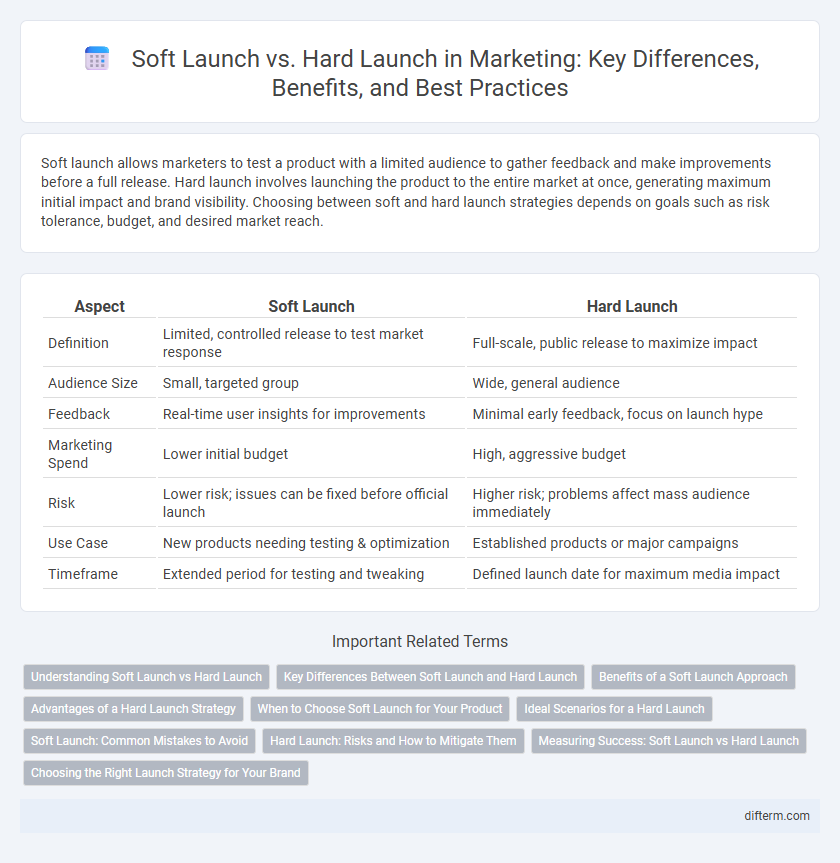Soft launch allows marketers to test a product with a limited audience to gather feedback and make improvements before a full release. Hard launch involves launching the product to the entire market at once, generating maximum initial impact and brand visibility. Choosing between soft and hard launch strategies depends on goals such as risk tolerance, budget, and desired market reach.
Table of Comparison
| Aspect | Soft Launch | Hard Launch |
|---|---|---|
| Definition | Limited, controlled release to test market response | Full-scale, public release to maximize impact |
| Audience Size | Small, targeted group | Wide, general audience |
| Feedback | Real-time user insights for improvements | Minimal early feedback, focus on launch hype |
| Marketing Spend | Lower initial budget | High, aggressive budget |
| Risk | Lower risk; issues can be fixed before official launch | Higher risk; problems affect mass audience immediately |
| Use Case | New products needing testing & optimization | Established products or major campaigns |
| Timeframe | Extended period for testing and tweaking | Defined launch date for maximum media impact |
Understanding Soft Launch vs Hard Launch
Soft launch allows companies to release a product to a limited audience, enabling real-time feedback and performance analysis before a full-scale market entry. Hard launch involves the official public release aimed at maximizing market impact and brand visibility with extensive marketing campaigns. Understanding the strategic use of soft launch versus hard launch helps optimize product rollout, minimize risks, and enhance customer reception.
Key Differences Between Soft Launch and Hard Launch
Soft launch involves releasing a product or service to a limited audience to gather feedback and identify issues, enabling iterative improvements before wider availability. Hard launch is the official, full-scale release targeting the entire market with comprehensive marketing campaigns and high visibility. Key differences include audience scope, marketing intensity, risk exposure, and objectives: soft launch prioritizes testing and refinement while hard launch focuses on maximizing reach and sales impact.
Benefits of a Soft Launch Approach
A soft launch allows businesses to gather valuable user feedback and identify potential issues before a full-scale release, reducing risks and improving the final product. This approach enables targeted marketing efforts and budget optimization by focusing on a smaller, controlled audience. Early insights from a soft launch enhance customer satisfaction and increase the chances of long-term success in competitive markets.
Advantages of a Hard Launch Strategy
A hard launch strategy accelerates brand visibility by making a strong market entrance with full product availability, driving immediate consumer engagement and sales. It creates a sense of urgency and excitement, encouraging early adopters and media coverage that amplifies reach. Rapid feedback from a broad audience enables quicker adjustments and scalability to meet market demand effectively.
When to Choose Soft Launch for Your Product
Choosing a soft launch is ideal when testing product performance, gathering user feedback, and making iterative improvements before a full market release. This approach minimizes risk by targeting a smaller audience, allowing marketers to identify potential issues and optimize the product experience. Soft launches are commonly used for new apps, tech products, and services requiring real-world validation prior to wide-scale promotion.
Ideal Scenarios for a Hard Launch
A hard launch is ideal for products with a fully developed feature set and proven market demand, ensuring maximum visibility upon release. Businesses targeting rapid user acquisition and immediate revenue growth benefit from a hard launch's abrupt and comprehensive market entry. Established brands introducing major updates or entirely new offerings often choose hard launches to capitalize on existing customer loyalty and media attention.
Soft Launch: Common Mistakes to Avoid
Soft launch mistakes often include insufficient audience targeting, leading to unreliable feedback and skewed performance metrics. Neglecting to clearly define success criteria can result in misinterpreting user behavior and delaying necessary improvements. Overlooking technical issues during this phase may cause long-term damage to user experience and brand reputation.
Hard Launch: Risks and How to Mitigate Them
Hard launch in marketing carries significant risks including product failure, negative customer feedback, and brand reputation damage due to the immediate full-scale release. Mitigating these risks involves thorough market research, extensive beta testing, and well-prepared crisis management plans to address potential issues swiftly. Effective communication strategies and responsive customer support further reduce the impact of unforeseen problems during a hard launch.
Measuring Success: Soft Launch vs Hard Launch
Measuring success during a soft launch involves analyzing user engagement metrics, feedback quality, and initial retention rates to make iterative improvements before a full rollout. Hard launch success is evaluated through large-scale performance indicators such as market penetration, revenue growth, and overall customer acquisition cost. Comparing these metrics provides valuable insights into product readiness and market viability, enabling marketers to optimize their launch strategies effectively.
Choosing the Right Launch Strategy for Your Brand
Choosing the right launch strategy between a soft launch and a hard launch depends on your brand's goals, target audience, and product readiness. A soft launch allows for collecting user feedback and making iterative improvements with minimal risk, ideal for startups testing market fit. In contrast, a hard launch delivers a full-scale, high-impact release aimed at maximum visibility and rapid market penetration, suitable for established brands seeking immediate growth.
Soft Launch vs Hard Launch Infographic

 difterm.com
difterm.com